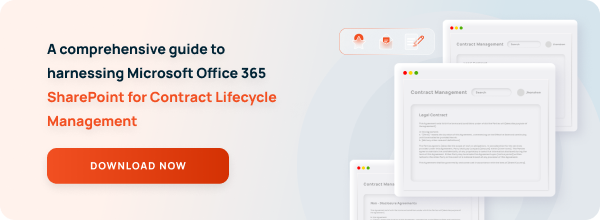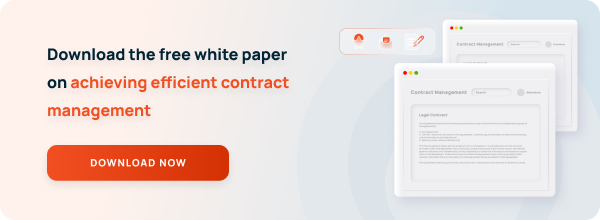
Top 5 Common Challenges Faced in Contract Management Without the Use of Software
Although managing hundreds of contracts manually might be highly challenging, contract management is an essential work in any business organization. While every organization differs, many essential contract management challenges apply across all business roles, regions, and sectors.
ConvergePoint outlines the top 5 common contract management challenges and suggests practical solutions for every business organization. Businesses may improve overall productivity, compliance, and efficiency by addressing these problems.

Poor Understanding of the Contracting Process
A significant challenge without having contract management software that many businesses face is a lack of understanding of the actual contract processes. Team members get confused when they don't understand the proper procedures for creating, reviewing, and executing the contracts.
Miscommunication leads to inaccurate delays and dependence on guesswork can negatively impact business operations. Proper training and standardized processes are important to ensure everyone involved knows what steps to follow to reduce bottlenecks and improve overall productivity.
Missing Contracts
71% of companies couldn't find at least 10% of their contracts, according to a Journal of Contract Management report.
Missing contracts can create significant challenges for organizations. When important contract documents go missing, it can cause confusion, delays, and even legal issues. Without quick access to important contracts, organizations may find it difficult to adhere to deadlines, comply with obligations, or settle disputes.
Missing contracts can also cause issues with day-to-day operations and impact relationships with clients or partners. To prevent these risks, organizations must implement solid procedures in place to ensure contracts are securely stored and quickly accessible when required.
Lack of Visibility in Contracts
Many organizations’ non-legal departments struggle to get essential contract information. This lack of visibility in contracts makes it challenging for these teams to maintain compliance with contractual terms and regulations, resulting in performance concerns and an increased risk of contract breaches.
When these departments work without common access to contract documents, they miss an opportunity to monitor performance. Transparent access to contract documents across departments encourages collaboration and accountability, hence keeping the business on track.
Also read: Contract Management Six Sigma Process Improvement in Legal Services
Redlining Standard Agreements
Contract redlining sometimes includes numerous parties and amendments to a contract agreement before it has been finalized. As the parties make more revisions to the contract manually, it becomes more difficult to understand, and errors may occur.
Multiple contractual modifications may result in incorrect formatting, requiring unnecessary time to reformat the contract document. This slowed down the negotiating phases.
Poor Metrics Tracking
Managing contract information manually and using spreadsheets for tracking contract documents may create significant challenges for organizations. This manual process is quite time-consuming as well as prone to error. The absence of accuracy in current information makes it difficult to evaluate contract performance and identify areas that require improvement.
Inadequate metrics tracking shrinks a company's ability to make informed decisions and improve its contract management processes. Investing in automated solutions for tracking, managing, and evaluating contract information is necessary to maintain productivity and improve efficiency.
How do you overcome contract management challenges?
Identify Gaps and Areas for Improvement
The first step to overcoming contract management challenges is to take an in-depth look at your current contract processes. To identify any gaps or weak points, organizations need to invest the time to map out each phase of their contract management workflow.
By analyzing past contracts and their outcomes, organizations can identify what worked and what didn't and make well-informed decisions to improve future negotiations and agreements. This key reflection and planning are important for long-term success in contract management processes.
Implementing a Centralized Contract Repository
Implementing a centralized repository is one of the best ways to keep contracts organized to avoid issues. By storing all contract documents in one place, you can ensure that team members who have authorization can access them when needed.
Along with this, a strong search function will allow contracts to be found quickly, while version control helps you stay on top of every revision. This approach decreases the risk of losing important contract documents, keeping everything clear and accessible in a single and organized system.
Improve Cross-Departmental Collaboration
The legal department is not the only one responsible for contract management. To make sure that obligations are carried out and tracked, non-legal departments also require accessibility to contract information. Using contract management software, allowing seamless sharing of contract information across departments helps improve cross-departmental communication.
Organizations can ensure that all parties adhere to compliance with the terms of contracts by providing the necessary access to the various departments. Throughout the entire contract lifecycle, smoother operations are recommended, and the risk of non-compliance decreases with this level of transparency.
Related Article: How to Implement End-to-End Contract Lifecycle Management (CLM) Software
Standardize Contract Templates
Organizations should create standardized contract templates that include common business terms to speed up the contract negotiating process. The negotiation process can be improved by using clear and standardized templates, which also decrease the need for unnecessary redlining. However, it is equally important to educate stakeholders on the significance of following these templates.
Maintaining open lines of communication with negotiation partners is important for ensuring mutual understanding and reducing the possibility of miscommunication and prolonged back-and-forth modifications.
Related Article: Best Practices to Improve Contract Negotiations
Implement Contract Management Software
When using manual contract processes, it can be challenging to keep track of how well contracts are being performed. Organizations may take this into account by considering contract management software, which automates the collection and reporting of contract-related information.
The key performance indicators (KPIs) such as contract duration, compliance rates, and performance are easily tracked with the help of the contract management software, providing valuable information on how well contracts are managed.
Organizations may quickly identify areas for improvement, make data-driven decisions, and continually improve their contract management processes by automating metrics tracking. This improves overall performance and increases the efficiency of contract management.
Related Article: Contract Review and Analysis with AI
Why is ConvergePoint's Contract Management Software the best choice to overcome these challenges?
ConvergePoint's Contract Management Software is designed to address the challenges that organizations experience when managing contracts. It enables improved contracting by helping users throughout the lifecycle, clarifying any misunderstandings, and reducing delays.
Additionally, it provides advanced features like version control and search functionality to prevent contracts from missing and ensure deadline compliance, as well as secure contract storage in a centralized repository.
By giving authorized users access to contract information, our software increases departmental visibility and promotes better collaboration among departments. In addition, it speeds up the redlining process by enabling seamless collaboration on contract changes to improve overall contract management performance and make informed decisions.
Are you ready to transform your contract management processes? Request a demo today to see how ConvergePoint can help your organization overcome these challenges and streamline contract management for improved outcomes!
Download the Contract Management White Paper
News & Blog
Check out our latest blogs and updates on contract management






